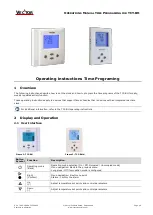
5
MAINTENANCE INSTRUCTIONS FOR
SMALL AND LARGE BYPASS HUMIDIFIERS
CAUTION! Sudden operation may cause personal injury or property damage.
Turn humidistat to “OFF” before servicing.
1.
Note humidistat setting and turn humidistat to the “OFF” position.
2.
At the side of the unit opposite the airflow duct, pull front cover (1) off holding with both hands
and set aside.
3.
Carefully pull the plastic feed tube (2) out of the nozzle (3) at the top of the Water Panel evapo-
rative assembly (4). Pull this assembly out by grasping at top and tipping out.
4.
Slide the evaporative media (4) out from the white plastic Scale Control Insert (5). Clean the
insert frame by twisting and flexing it to loosen the calcium deposits, or use a putty knife.
Replace the evaporative media (Part No. P110-1045 for Small Bypass Humidifier and Part No.
P110-3545 for Large Bypass Humidifier) and slide the pad back into the scale control insert
frame with color mark up. Snap the black distribution tray (2) back into place.
5.
Reinstall the Water Panel evaporative assembly into the unit by fitting its drain tube into the
round receptacle at the base of the unit. Push the assembly in at the top against the beveled
tabs that will hold it in place. Push the end of the feed tube back firmly into the nozzle and
replace the front cover.
6.
Remove the drain hose (6) from the bottom of the unit and bend and flex it to loosen the
internal calcium deposits. Then flush it with water under pressure and slip it back onto the
black drain fitting.
7.
Reset the humidistat and check unit operation.
1. Front Cover
2. Feed Tube
3. Nozzle
4. Water PanekEvaporative
Assembly
5. Distribution Tray
6. “V” Notches
7. Water Panel
8. Scale Control Insert
9. Drain Hose
benefits from it. This booklet is intended to answer these questions.
The humidifier operates in conjunction with the furnace blower motor. When
the humidistat calls for humidity and the blower motor is operating, water flows
to the distribution pan located at the top of the unit. The water is uniformly dis-
tributed across the width of the pan and through a scientifically designed system
of outlets. It flows by gravity over the evaporative media. Dry, hot air is moved
through the moisture-laden evaporative media where evaporation takes place.
The now-humidified air carries moisture in vapor form throughout the home.
The correct water flow is determined by an orifice in each unit. When
the unit is operating, there will be a small, steady stream of water to drain,
which flushes away most of the trouble-causing minerals.
Do not use the
saddle valve to regulate the water flow. It is designed to be completely opened
or closed.
The minerals and solid residue not trapped by the replaceable evaporative
media are flushed down the drain. The drain also eliminates the problems
caused by stagnant water. This is the most effective and least expensive
method to dispose of trouble-causing minerals.
Trouble-free performance and minimum maintenance are assured by the
design features of the humidifier. All unit housing parts that come in contact
with water are non-metal and will never rust or corrode. Neither heat nor water
will affect them under normal operating conditions.
The evaporative media, designed especially for uniform, high evapora-
tion, and the Scale Control Insert also efficiently trap mineral deposits which
are often the cause of damage to working parts in ordinary humidifiers. No
“white dust” can be distributed throughout the living quarters. The evaporative
media must be in good condition to assure high capacity trouble-free perform-
ance. It should be changed annually.
The granular coating in the bottom of the distribution tray is designed to
provide equal distribution of water to each of the openings assuring an even
flow of water over the evaporative media. Do not clean the mineral scale off the
bottom of the water distribution tray at the end of the humidification season.
The scale provides an excellent track for the water to follow. This is actually
what we try to simulate with the synthetic coating in the bottom of the tray. If
the coating is removed, it is not necessary to purchase a new distribution tray.
You can accomplish the same uniform performance by applying a small
amount of liquid dish soap over the entire lower surface of the water distribu-
tion tray. This will allow the water to flow evenly through each of the openings.
2






















